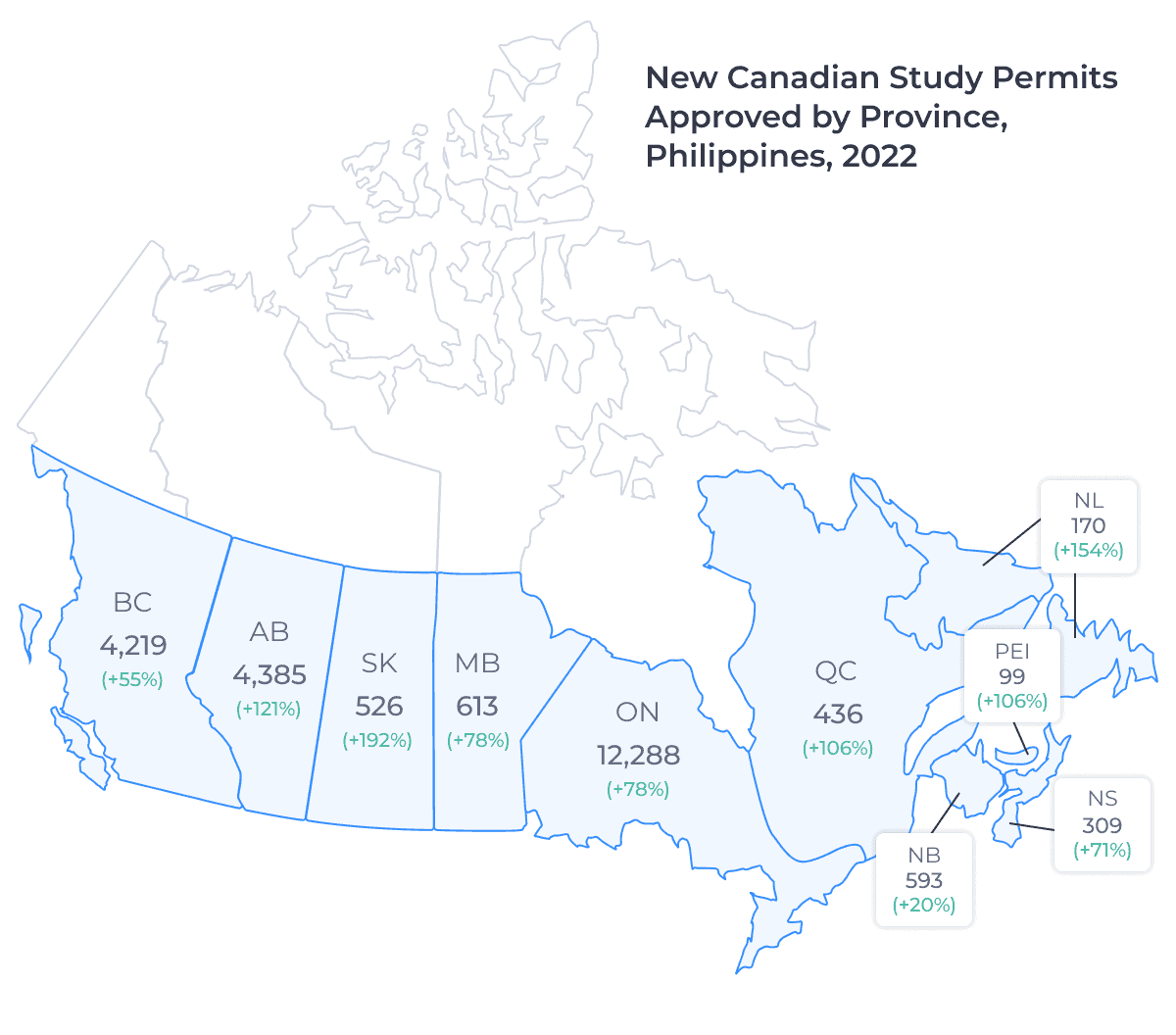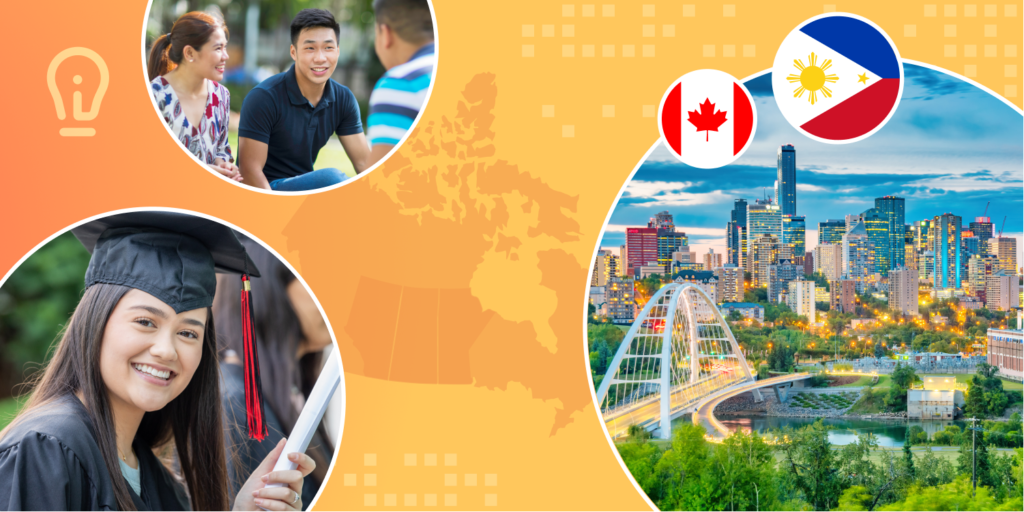The Philippines has cemented its position as a major source market for international students in Canada, surpassing China and France to become the country’s second-largest source market in 2022. Nearly 24,000 Filipinos were approved to study in Canada last year, up from 13,000 in 2021 and just 5,000 in 2019. This rapid growth showcases the Philippines’ increasing significance as a key contributor to Canada’s diverse student population.1
How have study permit trends for the Filipino market shifted in Canada over the past year? Where are Filipino students studying, and what are they studying when they get there? What are the top study levels that Filipino students are choosing in Canada? Let’s dive right in.
Key Insights at a Glance
- Study permit numbers from the Philippines grew at both the primary and secondary levels, with a 126% increase in secondary approvals and a 120% increase in primary approvals in 2022.
- According to ApplyBoard internal data, the average age of Filipino students applying to study in Canada on the ApplyBoard Platform was 31 in 2022.
- Strong growth in Alberta and Saskatchewan made the Prairies the fastest-growing destination for Filipino students in Canada last year.
Record-Breaking Study Permit Approval Numbers for Filipino Students in 2022
Let’s take a look at how study permit applications and approvals for Filipinos have fared over the past seven years:
Last year, there was an increase in interest among Filipino students coming to study in Canada, with 69% more applications compared to 2021. Overall, there were nearly 35,000 study permit applications from Filipino students in 2022.
Study permit approvals soared to an all-time high of nearly 24,000, 10,600 more than the previous year. In 2021, approvals for the Philippines grew significantly, with a 156% increase in approvals compared to 2019. This momentum continued into 2022, as approvals grew by 80% from 2021.
Filipino applicants saw impressive approval rates in 2022, with approximately 69% of their applications being approved, marking a five percentage point increase compared to 2021. These statistics deliver promising news for Filipino students aspiring to study in Canada, as approval rates have rebounded following the pandemic, exceeding the all-markets average by 12 percentage points last year.
K-12 Emerges as the Fastest-Growing Study Level for Filipino Students in 2022
Despite the Philippines being a historically college-driven market, we’re seeing more Filipino students approved at the K-12 level than ever before. Let’s take a look at which study levels Filipino students are pursuing in Canada:
College programs were highly sought-after among Filipino students. In 2022, college approvals grew by 70%, surpassing 14,700 study permit approvals. The increase in the number of parents bringing their children as dependents to study in Canada has driven a rise in K-12 Filipino students. This resulted in a slight decrease in the college market share, with 62% of Filipino students approved for a college program, compared to 66% in 2021.
At the university level, the number of approvals grew to over 1,400 in 2022, reflecting an impressive growth rate of 41% in 2022 compared to 2021. This growth was primarily fuelled by the popularity of undergraduate programs, which saw a surge of 69%. Master’s programs also experienced strong growth of 32%.
Parents Embrace Studying Abroad Together, Including Their Children
According to ApplyBoard internal data, a significant proportion of Filipino students choosing to study in Canada were working-age adults, with many hoping to relocate their families as well. In 2022, the average age of Filipino students applying to study in Canada through the ApplyBoard platform was 31. With more mature Filipino students coming to study in Canada, there has been a noticeable rise in Filipino students bringing their children to Canada, resulting in an increase in primary and secondary enrollment numbers.
K-12 was the fastest-growing study level among Filipino students in 2022, with more than 1 in 4 new study permits approved for Filipinos for a K-12 program, with over 6,700 approvals. K-12 studies had a growth rate of 122% in 2022. While primary approvals grew five times faster than the secondary level across all Canadian source countries, the Philippines saw a different trend. The Philippines had growth at both the primary and secondary levels, with a 126% increase in secondary approvals and a 120% increase in primary approvals.
From speaking with our recruitment partners in-market, we know that a significant number of Filipino students perceive studying abroad as their initial stride toward immigration. Many of these students are looking for a pathway to obtain permanent residency (PR) in their chosen destination country. Canada, with its attractive Post-Graduation Work Permit Program (PGWPP), stands out among other English-speaking study-abroad destinations. The PGWPP continues to play a pivotal role in the surge of applications from the Philippines.
More Filipino Students are Studying in the Prairies
So, where are Filipino students headed to study in Canada? Let’s dive into which destination provinces Filipino students are studying in:

Alberta and Saskatchewan made the Prairies the fastest-growing region for Filipino students approved to study in Canada last year. In Alberta, approvals surged by 121% to nearly 4,400, while Saskatchewan experienced a remarkable three-fold increase with over 500 approvals in 2022. Despite not reaching the same levels as its Prairie counterparts, Manitoba demonstrated strong growth of 78%, surpassing 600 approvals for Filipinos.
Filipino students held a relatively higher market share of new study permit approvals in Alberta when compared to other markets. In 2022, approximately 1 in 5 study permit approvals for Filipino students were granted for institutions in Alberta, whereas the ratio was only 1 in 20 for all markets combined.
More popular destinations like Ontario, British Columbia, and Quebec also saw significant growth. Ontario grew by 78%, with over 12,000 approvals, accounting for 52% of all approvals last year. Despite not traditionally being a favored choice for Filipino students, Quebec saw a significant upswing in 2022, with approvals soaring by 106%—a growth rate surpassing that of British Columbia by 51 percentage points.
Atlantic Canada emerged as a flourishing destination, surpassing 1,100 approvals last year. Notably, Newfoundland and Labrador experienced a growth rate of 154%, making it the fastest-growing Atlantic province for Filipino students. New Brunswick, the largest market in Atlantic Canada for Filipino students, exhibited a comparatively moderate growth rate of 20% in 2022. Meanwhile, Nova Scotia has been gaining traction among students from diverse source countries, including the Philippines, witnessing an impressive increase of 71% in approvals.
Top Metro Areas for Filipino Students
Let’s take a closer look at some of the top metropolitan areas for Filipino students studying in Canada in 2022:
In 2022, Toronto remained the top choice for Filipino students studying in Canada. However, Western Canadian cities are rapidly gaining popularity among Filipino students. Several growing metropolitan areas attracted a significant number of Filipino students. Interestingly, more Filipino students where students opted for less densely populated cities in 2022. In terms of overall study permits issued, the Philippines accounted for approximately 5% of the total, with Filipino students gravitating towards metropolitan areas such as Calgary and Edmonton in Alberta, as well as London, Ontario.
Calgary and Edmonton are metro areas with large Filipino populations and existing Filipino cultural hubs, and these are likely significant pull factors for incoming students. Calgary, in particular, had not only the highest market share of new study permits approved for Filipino students last year but also the fastest-growing Filipino population of any Canadian city.
Looking Forward
Given the Canadian government’s unwavering support for international student mobility and the continuing interest among Filipino students in studying abroad, the future holds immense potential for the Philippines as a thriving source market for international education in Canada.
With Filipino students headed to the Canadian Prairies, particularly Alberta, and Saskatchewan, there are more opportunities for institutions in these destination provinces to attract more Filipino students. Institutions looking to capitalize on these shifting trends in the Canadian international education market can:
- Make local school boards aware of a potential influx of Filipino students and encourage them to develop specialized curricula, language support programs, and cultural integration initiatives for K-12 to ensure Filipino students are supported.
- Foster community engagement by establishing student associations, cultural clubs, and mentorship programs that provide opportunities for Filipino students to connect with their peers, engage in cultural activities, and build a strong sense of community on campus.
- Familiarize themselves with the rural immigration pathways pilot programs that are attracting Filipino applicants to Western Canada.
- Provide support services, including academic guidance, language assistance, cultural orientation programs, and mental health support to ensure a smooth transition and successful academic journey for Filipino students.
Subscribe to ApplyInsights
Sign up for the latest insights on international education.

About the ApplyInsights Team
FOOTNOTES:
1. All data courtesy of Immigration, Refugees and Citizenship Canada (IRCC).



